Table of Content
Home inventory business plan for starting your own company
Do you want to start your business with the least possible investment? This business plan for home inventory business can make that possible for you. In the following text we’ll tell you how to run a home inventory business. All you have to do is to keep record of what people have at home. Simple as that!
This business is a very simple one. You do not need a lot of cash to get started with it as you would need for real estate business plans. It makes this the best business plan for investors who are short on cash. We’ll follow the example of Cobol Home Inventory Reporting.
Executive Summary
2.1 The Business
Cobol Home Inventory Reporting will be a licensed, ensured, and bonded home inventory services provider situated in Fort Lauderdale and operate in all of Florida. This home inventory business start up will be owned by Dickard Cobol.
Let’s see how to start a home inventory business.
2.2 Management of Home Inventory Company
If you want to know how to create an inventory system for small home business, keep reading. For the business to be successful it must have multiple locations across Florida. This calls for creating a franchise business plan.
The management of this business will be divided into two parts. One will be responsible for operations and the other will look after the external relations and PR.
2.3 Customers of Home Inventory Company
The customers of the Home inventory business will be of three main categories:
- People who want to keep track of their personal belongings.
- Insurance companies who need reporting on the home inventory of the insured people.
- The government can also be a customer if they want to get the inventory details of a crime scene.
2.4 Business Target
The target of the business is to ultimately become the only nationwide home inventory service. This is just like that of a a. The objective targets are:
- Expanding to at least 3 states by the end of year 1.
- Obtaining at least 10 large clients within 6 months.
- Increasing the annual revenue to $311,000 by the end of year 3.
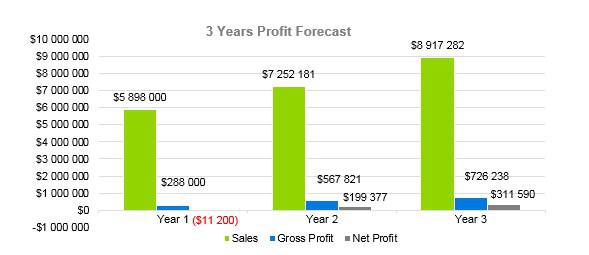
Company Summary
3.1 Company Owner
The owner of the Cobol Home Inventory Reporting will be Dickard Cobol. Cobol will also act as the CEO of the company. An experience of 30 years in the insurance adjustment industry has earned Cobol a lot of contacts. Those people can make this inventory business plan sample successful.
3.2 Why the Home Inventory Business being started
Cobol is starting a home inventory business mainly because he has a lot of experience. Another reason behind him starting this business is the recent increase in the need for this field. When people get their homes insured, the stuff inside is also insured. To make sure that they claim what they actually had, the need for home inventory reporting has skyrocketed following the recent storms in America.
3.3 How the Home Inventory Business will be started
Step1: Planning
The first step in starting this business is making the business plan inventory example. This is the stage where it will be planned what services we will provide and to what extent. The market segments to be focused in the business will also be determined in this step. Before you go ahead for home inventory business plan download, you need to read it.
Step2: Define the Brand
This is not a resort business plan where you can spend a lot of money to make more. You need to establish a brand. This can only be done by portraying an image of fair practices and exalted service. You will need to come up with a great name, logo, and tagline for the brand.
Step3: Establish Your Office
The next step will be to establish an office. This is must to get the trust of the clients.
Step4: Online Presence
Unlike a real estate agency business plan, this business needs an online presence. You need to make a website for your clients to connect with you.
Step5: Marketing
You need to market your services via print, electronic and social media.
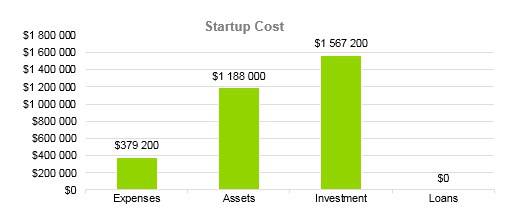
| Start-up Expenses | |
| Legal | $247,000 |
| Consultants | $0 |
| Insurance | $31,000 |
| Rent | $19,000 |
| Research and Development | $26,000 |
| Expensed Equipment | $52,000 |
| Signs | $4,200 |
| TOTAL START-UP EXPENSES | $379,200 |
| Start-up Assets | $338,000 |
| Cash Required | $345,000 |
| Start-up Inventory | $50,000 |
| Other Current Assets | $217,000 |
| Long-term Assets | $238,000 |
| TOTAL ASSETS | $1,188,000 |
| Total Requirements | $1,567,200 |
| START-UP FUNDING | |
| Start-up Expenses to Fund | $379,200 |
| Start-up Assets to Fund | $1,188,000 |
| TOTAL FUNDING REQUIRED | $1,567,200 |
| Assets | |
| Non-cash Assets from Start-up | $1,576,000 |
| Cash Requirements from Start-up | $360,000 |
| Additional Cash Raised | $53,000 |
| Cash Balance on Starting Date | $32,000 |
| TOTAL ASSETS | $2,021,000 |
| Liabilities and Capital | |
| Liabilities | $30,000 |
| Current Borrowing | $0 |
| Long-term Liabilities | $0 |
| Accounts Payable (Outstanding Bills) | $41,000 |
| Other Current Liabilities (interest-free) | $0 |
| TOTAL LIABILITIES | $71,000 |
| Capital | |
| Planned Investment | $1,567,200 |
| Investor 1 | $0 |
| Investor 2 | $0 |
| Other | $0 |
| Additional Investment Requirement | $0 |
| TOTAL PLANNED INVESTMENT | $1,567,200 |
| Loss at Start-up (Start-up Expenses) | $382,800 |
| TOTAL CAPITAL | $1,950,000 |
| TOTAL CAPITAL AND LIABILITIES | $2,021,000 |
| Total Funding | $1,567,200 |
Services
Before you can start a home inventory service business, you need to have a solid home inventory business plan. As this is not as simple as making a property management business plan, you need to define the services that you will be giving to the clients. Our services for this company will be divided into three categories:
- Domestic Home Inventory Service
This segment will make up for the largest number of clients but with small revenue per client. The services provided to these clients will include:
- Maintaining a list of home inventory for their personal reference.
- Preparing home inventory lists for insurance purposes.
- Reporting the inventory in case of damage to the property.
For this segment of the customers, we will have lesser customers but each of them will give us substantial revenue. The services for these customers will include:
- Home inventory reporting for the insured homes.
- Inventory reporting for non-residential insured properties.
- Presenting inventory reports to the concerned authorities when needed.
These clients will also be in lower numbers but will be high-paying. We will provide them these services:
- Inventory record management for offices.
- Inventory reporting for insurance purposes.
For people who would want to keep record of their belongings themselves, we’ll be offering a user-friendly mobile app. Through app that will come up with a subscription fee, our customers will be able to keep record of their kitchen inventories and more.
Marketing Analysis of Home Inventory Company
excellent work
excellent work, competent advice. Alex is very friendly, great communication. 100% I recommend CGS capital. Thank you so much for your hard work!
For successfully running a home inventory company, you need to know how to do a home inventory for insurance. But even before that, you need to know the market. Even before you start a home inventory business. A recent report has determined that in the USA more than half of the homeowners do not have a home inventory. Keeping in mind that the market has such a huge gap, a property inventory business plan is all you need to start a profitable business. All you need to do is to have a staff that knows how to make a home inventory.
The next thing you need to do is to have a look on the current market trends of the industry to see how you can enter. As a new entrant, you will have to present something that your competitors lack. Only then you can have a reasonable chance of being successful at this business.
5.1 Market Trends
After it was made necessary by the law to maintain a home inventory with a licensed provider, following the Hurricane Katrina, the home inventory business has grown very much. Previously it was something reserved for the ultra-rich. A middle-class man does not have too much stuff to have something note it down for them.
However, now Uncle Sam wants your MacBook and washing machine on the list. If they are not, your chances of getting insurance compensation diminish greatly. This automatically means that the home inventory service providers are in luck. Now is the time to capture this market before it saturates like many others.
Let’s now see the marketing segmentation to better know how to plan this business.
5.2 Marketing Segmentation
The potential customers of our home inventory reporting business will be the following:
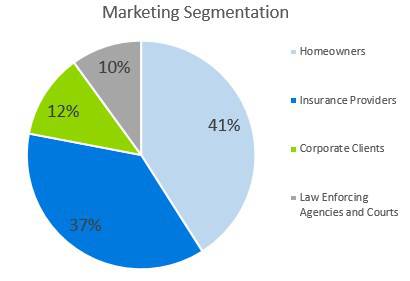
5.2.1 Homeowners
This is the segment of the market that will account for the largest number of customers. We will give them the services of keeping a record of their home possessions. In case their property is lost, we can present the inventory to the insurance company or law enforcing agencies handling the case.
5.2.2 Insurance Providers
Insurance companies need the services of home inventory reporting companies to report on the possessions of the insured homeowners. This segment will be the source of the bulk of our cashflow.
5.2.3 Corporate Clients
These clients need someone to keep track of all the stuff in their offices. These clients will be a few but their projects are large.
5.2.4 Law Enforcing Agencies and Courts
These bodies can sometimes ask home inventory reporting companies to report on the possessions of homeowners. These clients are not regular ones but offer better payout.
| Market Analysis | |||||||
| Potential Customers | Growth | Year 1 | Year 2 | Year 3 | Year 4 | Year 5 | CAGR |
| Homeowners | 41% | 43,000 | 45,000 | 48,000 | 50,000 | 53,000 | 10.00% |
| Insurance Providers | 37% | 40,000 | 42,000 | 45,000 | 47,000 | 50,000 | 10.00% |
| Corporate Clients | 12% | 12,000 | 13,000 | 14,000 | 15,000 | 16,000 | 10.00% |
| Law Enforcing Agencies and Courts | 10% | 6,500 | 7,000 | 8,000 | 9,000 | 10,000 | 11.00% |
| Total | 100% | 101,500 | 107,000 | 115,000 | 121,000 | 129,000 | 10% |
5.3 Business Target
- To sign contracts with the 10 major insurance providers in Florida.
- To achieve and maintain an average rating above 4.5 throughout our service years.
- To make at least $311,000 in profits per annum by the end of year 3.
- To obtain and retain a CSAT score of 95%.
5.4 Product Pricing
The prices for our services will be higher than the competitors. This is because of the experience of the founder and the dedication of our team. However, we’ll offer discounts at the start. This is not a business plan for painting company. We need to charge for what we are doing.
Marketing Strategy of Home Inventory Company
Of all the things that make it successful, marketing a home inventory business is the most important factor. Before you open a home inventory business franchise, you need to have a solid marketing strategy.
For making an effective marketing strategy, it is important to perform an extensive competitive analysis and base your marketing and sales strategy on it.
6.1 Competitive Analysis
- After competitive analysis we have discovered that no home inventory business in Florida has a better experienced team.
- Another competitive advantage that Cobol Home Inventory Reporting has is the relations with the insurance industry leaders that Dickard Cobol has developed.
- Lastly, and the most importantly, Cobol Home Inventory Reporting will provide services to independent homeowners too, unlike any competitor.
6.2 Sales Strategy
- The business will be promoted by online ads and TV commercials and the marketing effort will be augmented by emailing insurance agencies.
- We will offer a flat 30% discount for the first 100 customers and 10 insurance agencies.
- We will establish an impeccable honesty and integrity reputation.
6.3 Sales Monthly
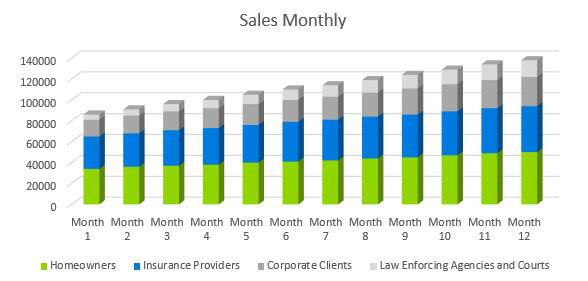
6.4 Sales Yearly
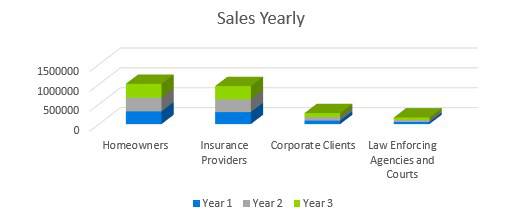
6.5 Sales Forecast
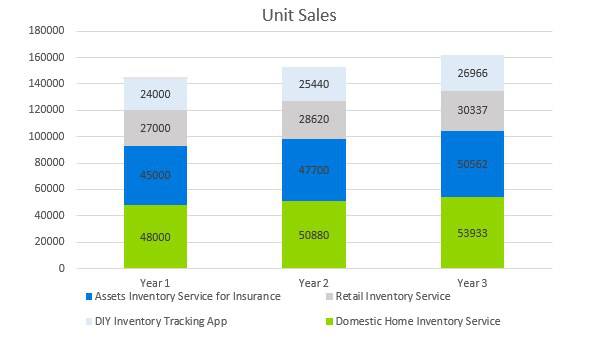
| Sales Forecast | |||
| Unit Sales | Year 1 | Year 2 | Year 3 |
| Domestic Home Inventory Service | 48,000 | 50,880 | 53,933 |
| Assets Inventory Service for Insurance | 45,000 | 47,700 | 50,562 |
| Retail Inventory Service | 27,000 | 28,620 | 30,337 |
| DIY Inventory Tracking App | 24,000 | 25,440 | 26,966 |
| TOTAL UNIT SALES | 144,000 | 152,640 | 161,798 |
| Unit Prices | Year 1 | Year 2 | Year 3 |
| Domestic Home Inventory Service | $43.00 | $49.88 | $57.86 |
| Assets Inventory Service for Insurance | $43.00 | $49.88 | $57.86 |
| Retail Inventory Service | $41.00 | $47.56 | $55.17 |
| DIY Inventory Tracking App | $33.00 | $38.28 | $44.40 |
| Sales | |||
| Domestic Home Inventory Service | $2,064,000.00 | $2,537,894.40 | $3,120,594.95 |
| Assets Inventory Service for Insurance | $1,935,000.00 | $2,379,276.00 | $2,925,557.77 |
| Retail Inventory Service | $1,107,000.00 | $1,361,167.20 | $1,673,691.19 |
| DIY Inventory Tracking App | $792,000.00 | $973,843.20 | $1,197,437.60 |
| TOTAL SALES | $5,898,000.00 | $7,252,180.80 | $8,917,281.51 |
| Direct Unit Costs | Year 1 | Year 2 | Year 3 |
| Domestic Home Inventory Service | $41.00 | $46.00 | $53.00 |
| Assets Inventory Service for Insurance | $41.00 | $46.00 | $53.00 |
| Retail Inventory Service | $39.00 | $44.00 | $51.00 |
| DIY Inventory Tracking App | $31.00 | $35.00 | $41.00 |
| Direct Cost of Sales | |||
| Domestic Home Inventory Service | $1,968,000.00 | $2,340,480.00 | $2,858,438.40 |
| Assets Inventory Service for Insurance | $1,845,000.00 | $2,194,200.00 | $2,679,786.00 |
| Retail Inventory Service | $1,053,000.00 | $1,259,280.00 | $1,547,197.20 |
| DIY Inventory Tracking App | $744,000.00 | $890,400.00 | $1,105,622.40 |
| Subtotal Direct Cost of Sales | $5,610,000.00 | $6,684,360.00 | $8,191,044.00 |
Personnel plan
Business plan for investors
For the home inventory business to run smoothly, we need trained professional staff. The staff will have to have two types of skills. If you want to make the most out of home inventory business opportunities, the staff is one of the most important factors determining your success.
7.1 Company Staff
- 1 Chief Operational Officer.
- 1 Liaison and PR Manager.
- 5 Surveyors to conduct field work.
- 1 IT Expert for managing the website, apps, and social media presence.
- 4 Drivers.
- 1 Peon for office work.
- 1 Office Boy to take care of office errands.
7.2 Average Salary of Employees
| Personnel Plan | |||
| Year 1 | Year 2 | Year 3 | |
| Chief Operational Officer | $14,000 | $15,400 | $16,940 |
| Liaison and PR Manager | $13,000 | $14,300 | $15,730 |
| Surveyors | $50,000 | $55,000 | $60,500 |
| Accountant | $9,000 | $9,900 | $10,890 |
| IT Expert | $8,000 | $8,800 | $9,680 |
| Peon | $7,000 | $7,700 | $8,470 |
| Office Boy | $7,000 | $7,700 | $8,470 |
| Drivers | $35,000 | $38,500 | $42,350 |
| Total Salaries | $143,000 | $157,300 | $173,030 |
Financial Plan
For running successful home inventory business, it is important to calculate the home inventory service cost. For that it is paramount to make a financial plan for the company. For the starting of the business, we will be focusing on the costs that we will incur to start the business. These will include:
- The cost for getting the office space.
- Cost for buying 4 pickup trucks for moving the crew.
- The salaries of the staff.
- The cost of advertisement and social media presence.
- The cost of overheads before the company starts making profit.
8.1 Important Assumptions
| General Assumptions | |||
| Year 1 | Year 2 | Year 3 | |
| Plan Month | 1 | 2 | 3 |
| Current Interest Rate | 8.22% | 8.23% | 8.28% |
| Long-term Interest Rate | 8.39% | 8.44% | 8.47% |
| Tax Rate | 23.10% | 24.10% | 25.50% |
| Other | 0 | 0 | 0 |
8.2 Break-even Analysis
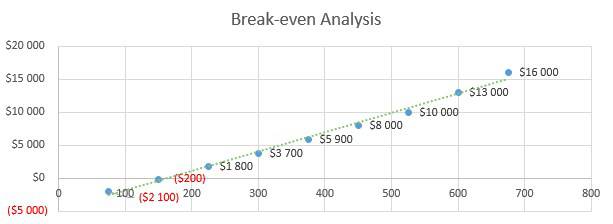
| Break-Even Analysis | |
| Monthly Units Break-even | 5344 |
| Monthly Revenue Break-even | $131,890 |
| Assumptions: | |
| Average Per-Unit Revenue | $236.00 |
| Average Per-Unit Variable Cost | $0.64 |
| Estimated Monthly Fixed Cost | $163,160 |
8.3 Projected Profit and Loss
| Pro Forma Profit And Loss | |||
| Year 1 | Year 2 | Year 3 | |
| Sales | $5,898,000 | $7,252,181 | $8,917,282 |
| Direct Cost of Sales | $5,610,000 | $6,684,360 | $8,191,044 |
| Other | $0 | $0 | $0 |
| TOTAL COST OF SALES | $5,610,000 | $6,684,360 | $8,191,044 |
| Gross Margin | $288,000 | $567,821 | $726,238 |
| Gross Margin % | 4.88% | 7.83% | 8.14% |
| Expenses | |||
| Payroll | $143,000 | $157,300 | $173,030 |
| Sales and Marketing and Other Expenses | $122,000 | $123,000 | $124,000 |
| Depreciation | $2,220 | $2,300 | $2,420 |
| Leased Equipment | $0 | $0 | $0 |
| Utilities | $2,980 | $3,000 | $3,100 |
| Insurance | $2,000 | $2,100 | $2,200 |
| Rent | $2,800 | $2,900 | $3,000 |
| Payroll Taxes | $27,000 | $28,000 | $29,000 |
| Other | $0 | $0 | $0 |
| Total Operating Expenses | $302,000 | $318,600 | $336,750 |
| Profit Before Interest and Taxes | ($14,000) | $249,221 | $389,488 |
| EBITDA | ($14,000) | $249,221 | $389,488 |
| Interest Expense | $0 | $0 | $0 |
| Taxes Incurred | ($2,800) | $49,844 | $77,898 |
| Net Profit | ($11,200) | $199,377 | $311,590 |
| Net Profit/Sales | -0.19% | 2.75% | 3.49% |
8.3.1 Profit Monthly
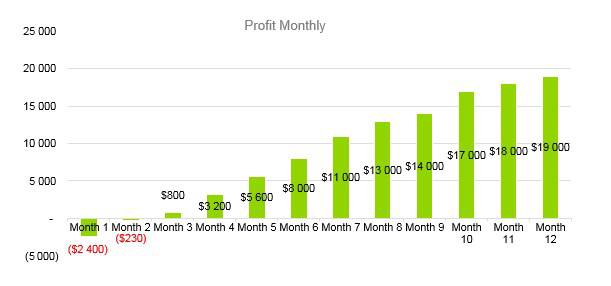
8.3.2 Profit Yearly
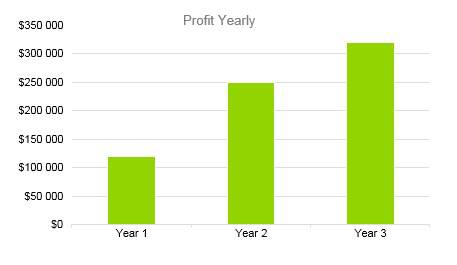
8.3.3 Gross Margin Monthly
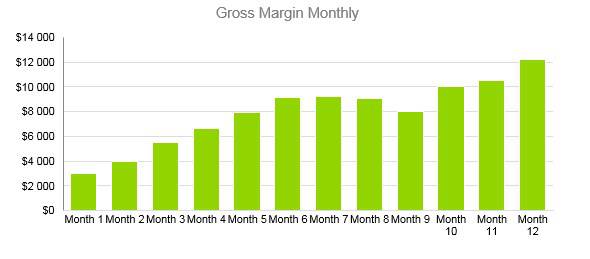
8.3.4 Gross Margin Yearly
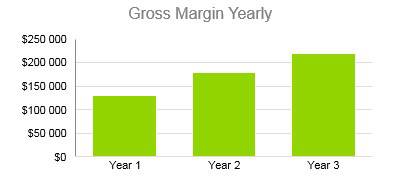
8.4 Projected Cash Flow
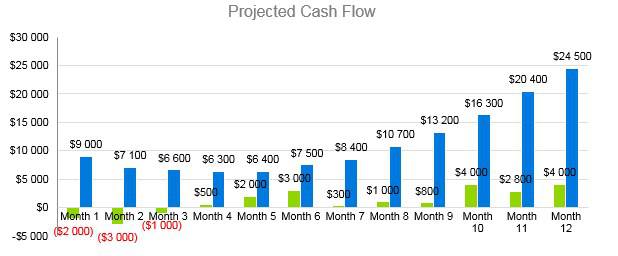
| Pro Forma Cash Flow | |||
| Cash Received | Year 1 | Year 2 | Year 3 |
| Cash from Operations | |||
| Cash Sales | $52,500 | $56,700 | $61,236 |
| Cash from Receivables | $18,700 | $20,196 | $21,812 |
| SUBTOTAL CASH FROM OPERATIONS | $71,200 | $77,608 | $83,817 |
| Additional Cash Received | |||
| Sales Tax, VAT, HST/GST Received | $0 | $0 | $0 |
| New Current Borrowing | $0 | $0 | $0 |
| New Other Liabilities (interest-free) | $0 | $0 | $0 |
| New Long-term Liabilities | $0 | $0 | $0 |
| Sales of Other Current Assets | $0 | $0 | $0 |
| Sales of Long-term Assets | $0 | $0 | $0 |
| New Investment Received | $0 | $0 | $0 |
| SUBTOTAL CASH RECEIVED | $72,000 | $78,000 | $84,000 |
| Expenditures | Year 1 | Year 2 | Year 3 |
| Expenditures from Operations | |||
| Cash Spending | $33,000 | $34,000 | $35,000 |
| Bill Payments | $18,500 | $19,800 | $21,000 |
| SUBTOTAL SPENT ON OPERATIONS | $51,500 | $53,800 | $56,000 |
| Additional Cash Spent | |||
| Sales Tax, VAT, HST/GST Paid Out | $0 | $0 | $0 |
| Principal Repayment of Current Borrowing | $0 | $0 | $0 |
| Other Liabilities Principal Repayment | $0 | $0 | $0 |
| Long-term Liabilities Principal Repayment | $0 | $0 | $0 |
| Purchase Other Current Assets | $0 | $0 | $0 |
| Purchase Long-term Assets | $0 | $0 | $0 |
| Dividends | $0 | $0 | $0 |
| SUBTOTAL CASH SPENT | $52,000 | $56,160 | $60,653 |
| Net Cash Flow | $16,000 | $17,000 | $18,000 |
| Cash Balance | $23,000 | $24,000 | $25,000 |
8.5 Projected Balance Sheet
| Pro Forma Balance Sheet | |||
| Assets | Year 1 | Year 2 | Year 3 |
| Current Assets | |||
| Cash | $268,000 | $300,160 | $330,176 |
| Accounts Receivable | $22,000 | $24,640 | $27,695 |
| Inventory | $4,000 | $4,480 | $4,900 |
| Other Current Assets | $1,000 | $1,000 | $1,000 |
| TOTAL CURRENT ASSETS | $286,780 | $321,194 | $361,022 |
| Long-term Assets | |||
| Long-term Assets | $10,000 | $10,000 | $10,000 |
| Accumulated Depreciation | $17,400 | $19,488 | $21,924 |
| TOTAL LONG-TERM ASSETS | $25,000 | $28,000 | $31,500 |
| TOTAL ASSETS | $296,000 | $331,520 | $372,960 |
| Liabilities and Capital | Year 4 | Year 5 | Year 6 |
| Current Liabilities | |||
| Accounts Payable | $18,720 | $20,966 | $23,566 |
| Current Borrowing | $0 | $0 | $0 |
| Other Current Liabilities | $0 | $0 | $0 |
| SUBTOTAL CURRENT LIABILITIES | $15,500 | $17,360 | $19,513 |
| Long-term Liabilities | $0 | $0 | $0 |
| TOTAL LIABILITIES | $15,000 | $16,800 | $18,883 |
| Paid-in Capital | $29,000 | $30,000 | $31,000 |
| Retained Earnings | $53,000 | $57,770 | $63,547 |
| Earnings | $190,000 | $207,100 | $227,810 |
| TOTAL CAPITAL | $281,200 | $306,508 | $337,159 |
| TOTAL LIABILITIES AND CAPITAL | $296,200 | $331,520 | $372,960 |
| Net Worth | $275,000 | $299,750 | $329,725 |
8.6 Business Ratios
| Ratio Analysis | ||||
| Year 1 | Year 2 | Year 3 | INDUSTRY PROFILE | |
| Sales Growth | 7.23% | 8.01% | 8.88% | 3.00% |
| Percent of Total Assets | ||||
| Accounts Receivable | 9.24% | 10.24% | 11.34% | 9.80% |
| Inventory | 5.44% | 6.03% | 6.68% | 9.90% |
| Other Current Assets | 2.14% | 2.37% | 2.63% | 2.40% |
| Total Current Assets | 149.00% | 151.00% | 152.00% | 158.00% |
| Long-term Assets | 11.32% | 11.37% | 11.44% | 12.00% |
| TOTAL ASSETS | 100.00% | 100.00% | 100.00% | 100.00% |
| Current Liabilities | 4.87% | 4.91% | 4.95% | 4.34% |
| Long-term Liabilities | 0.00% | 0.00% | 0.00% | 0.00% |
| Total Liabilities | 7.52% | 7.58% | 7.65% | 7.38% |
| NET WORTH | 100.23% | 101.03% | 101.96% | 110.00% |
| Percent of Sales | ||||
| Sales | 100.00% | 100.00% | 100.00% | 100.00% |
| Gross Margin | 94.06% | 96.60% | 99.30% | 99.00% |
| Selling, General & Administrative Expenses | 94.00% | 96.54% | 99.24% | 97.80% |
| Advertising Expenses | 1.50% | 1.54% | 1.58% | 1.40% |
| Profit Before Interest and Taxes | 41.00% | 42.11% | 43.29% | 33.90% |
| Main Ratios | ||||
| Current | 33 | 34 | 35 | 32 |
| Quick | 34 | 34.4 | 35.26 | 33 |
| Total Debt to Total Assets | 0.17% | 0.17% | 0.16% | 0.40% |
| Pre-tax Return on Net Worth | 72.00% | 73.20% | 74.00% | 75.00% |
| Pre-tax Return on Assets | 94.60% | 99.33% | 104.30% | 111.30% |
| Additional Ratios | Year 1 | Year 2 | Year 3 | |
| Net Profit Margin | 33.00% | 34.02% | 35.08% | N.A. |
| Return on Equity | 55.00% | 56.71% | 58.46% | N.A. |
| Activity Ratios | ||||
| Accounts Receivable Turnover | 7.7 | 7.8 | 7.8 | N.A. |
| Collection Days | 100 | 100 | 100 | N.A. |
| Inventory Turnover | 31.1 | 32.655 | 33 | N.A. |
| Accounts Payable Turnover | 15.4 | 15.7 | 16.2 | N.A. |
| Payment Days | 27 | 27 | 27 | N.A. |
| Total Asset Turnover | 2.5 | 2.5 | 2.6 | N.A. |
| Debt Ratios | ||||
| Debt to Net Worth | -0.04 | -0.03 | -0.04 | N.A. |
| Current Liab. to Liab. | 1 | 1 | 1 | N.A. |
| Liquidity Ratios | ||||
| Net Working Capital | $232,450 | $245,467 | $259,213 | N.A. |
| Interest Coverage | 0 | 0 | 0 | N.A. |
| Additional Ratios | ||||
| Assets to Sales | 0.86 | 0.87 | 0.87 | N.A. |
| Current Debt/Total Assets | 1% | 0% | 0% | N.A. |
| Acid Test | 28 | 28.5 | 29 | N.A. |
| Sales/Net Worth | 2.1 | 2.2 | 2.3 | N.A. |
| Dividend Payout | 0 | 0 | 0 | N.A. |
Download Home Inventory Business Plan Sample in pdf
OGS capital writers specialize in business plan themes such as property preservation business plan and many others.
OGSCapital’s team has assisted thousands of entrepreneurs with top-rate business plan development, consultancy and analysis. They’ve helped thousands of SME owners secure more than $1.5 billion in funding, and they can do the same for you.



















